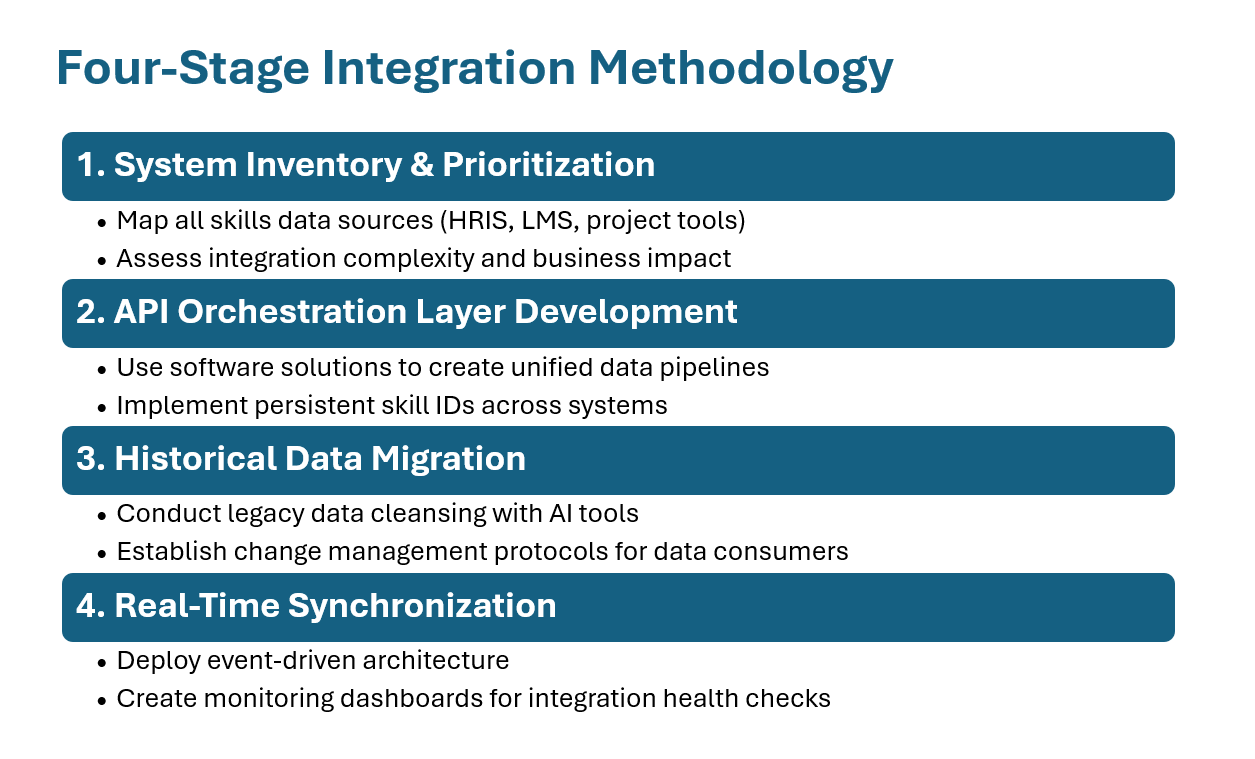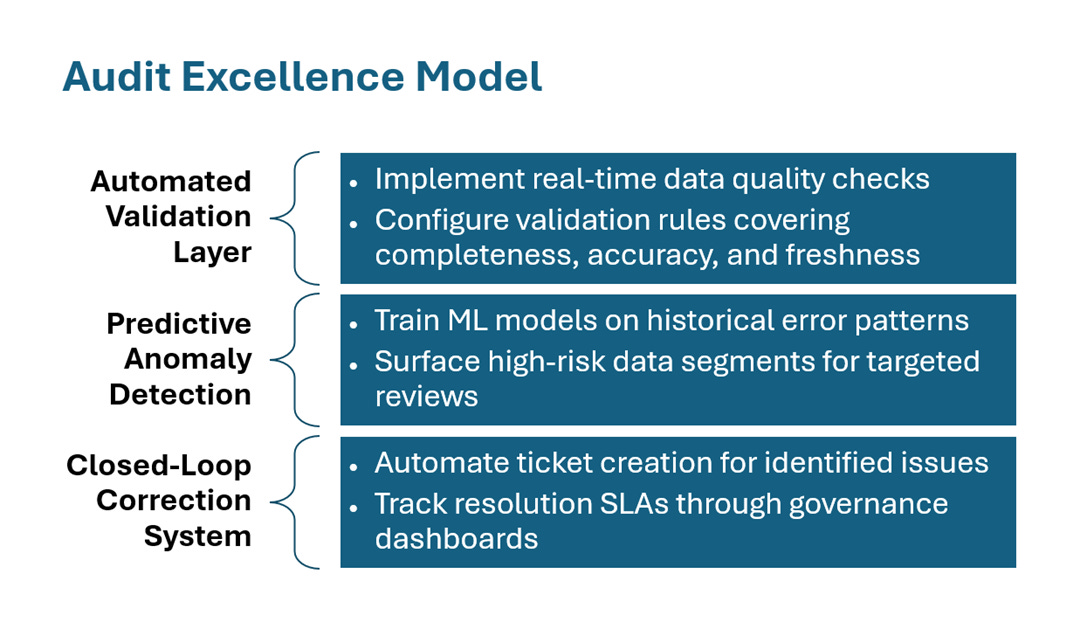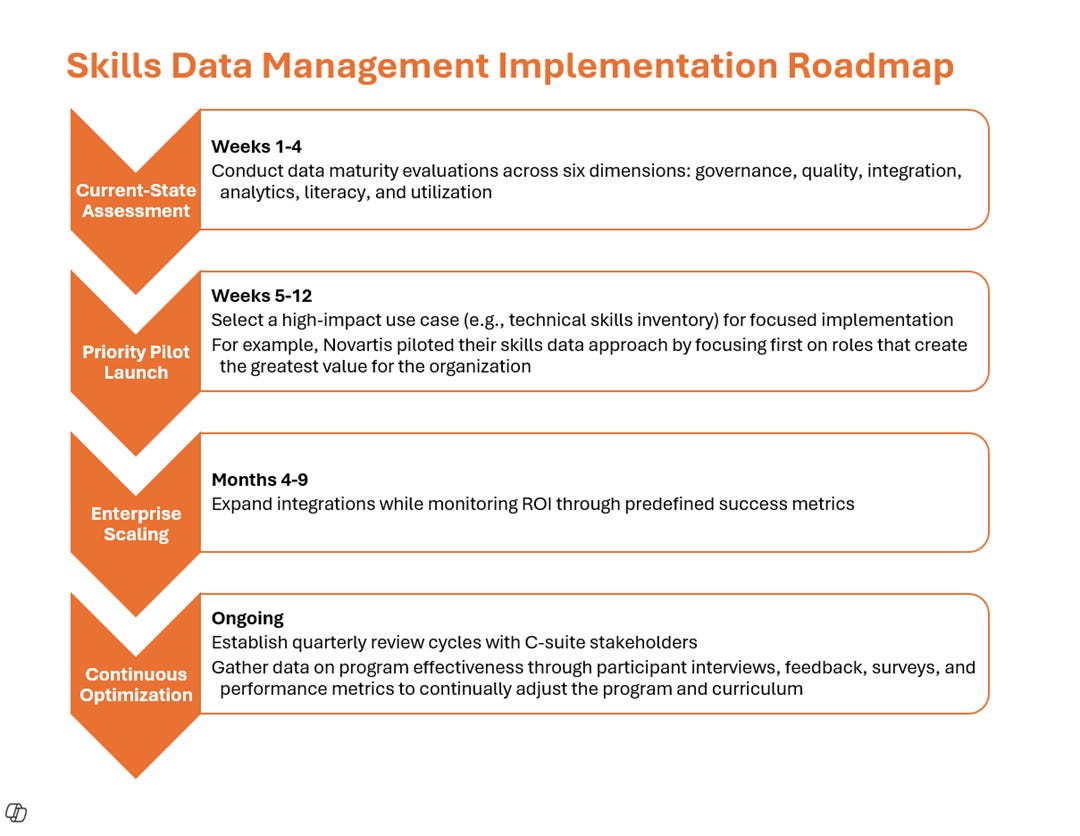Mastering Skills Data Complexity: Strategies for Sustainable Management
Overcoming Skills-First Implementation Challenges – Part 3
In today's data-driven business environment, managing the complexity of skills data collection is crucial for organizations implementing skills-first talent management. Yet, 74% of HR leaders report that data complexity undermines their ability to execute workforce strategies effectively. The challenge lies not only in collecting accurate data but also in maintaining its quality and usability across multiple systems and organizational units. This article provides actionable solutions to transform skills data from operational burden to strategic asset, with proven frameworks from industry leaders.
Architecting Data Governance for Enterprise-Wide Consistency
Establishing comprehensive data governance structures is the foundation of effective skills data management. These structures ensure the accuracy, reliability, and security of skills data throughout its lifecycle. According to recent studies, organizations with strong data governance frameworks experience a significant reduction in data-related errors and improved decision-making capabilities.
A robust data governance structure encompasses several key elements. First, organizations must develop clear policies and procedures for data collection, validation, and storage. These policies should define specific roles and responsibilities, including data stewards who oversee data quality and compliance. Additionally, organizations should establish enforceable quality standards that address the accuracy, completeness, and timeliness of skills data.
Furthermore, effective data governance requires regular monitoring and updates to ensure alignment with changing business needs and regulatory requirements. Organizations should implement validation checks at various data collection and processing stages to maintain data integrity. This proactive approach helps prevent data quality issues before they impact decision-making processes.
Core Components of Skills Data Governance
Creating a sustainable skills data governance framework requires several foundational elements:
Data Standards Committee: Cross-functional team overseeing taxonomy alignment and quality thresholds
Role-Based Access Controls: Granular permissions for viewing/editing sensitive skills data
Validation Protocols: Automated checks for completeness, accuracy, and relevance
Ownership Matrix: Clear accountability for data stewardship across HR, IT, and business units
Data Governance Implementation Blueprint
Form a Cross-Functional Data Governance Council
The first step in establishing effective data governance is creating a dedicated council with diverse expertise:
Composition: HR leaders, IT architects, legal advisors, and business unit representatives
Charter: Define data standards, ownership protocols, and compliance requirements
Example: Novartis's Skills Council reduced duplicate entries by 62% through quarterly taxonomy alignment sessions
The West Virginia Department of Education (WVDE) successfully implemented a multi-tiered system of data governance that included a Data Policy Committee to establish priorities and vision, a Data Governance Committee to manage implementation, and a group of Data Stewards to serve as liaisons for their program areas. 2 This approach improved data quality through better access and ownership. By allowing program staff appropriate access to the data system, they improved monitoring, reporting, and support capabilities while maintaining compliance with privacy regulations.
Develop Adaptive Data Policies
Organizations need flexible yet rigorous policies to govern skills data:
Create tiered access controls for sensitive skills information
Implement automated validation rules for real-time quality assurance
Establish escalation paths for data disputes and anomalies
Deploy Governance Technology Stack
Modern governance requires purpose-built tools for:
Metadata management
Data cataloging
Privacy compliance
Unifying Disparate Systems Through Strategic Integration
Integrating multiple legacy systems is one of the most significant challenges in managing skills data. Many organizations operate with disparate systems that have evolved over decades, creating data silos that hamper effective skills management. Research indicates that companies with integrated ERP and HR systems experience a 22% increase in operational efficiency.
Organizations should consider implementing centralized data repositories or data lakes to address this challenge. These solutions provide a unified view of skills data across the organization, enabling better analysis and decision-making. The integration process should be carefully planned and executed, considering factors such as data mapping and standardization across systems, security and access controls, real-time data synchronization capabilities, and scalability for future growth.
Four-Stage Integration Methodology
The Louisiana Department of Education (LDE) began work on its data governance program in 2012 when the state received its first SLDS grant. Initially, there was limited awareness of the need for data governance among stakeholders. The LDE developed its data governance policy and training, working with contractors and the SLDS Support team. A key success factor was organizational alignment - over time, more data staff reported to the same assistant superintendent, which proved helpful for data governance implementation. The structured approach improved relationships between data, IT, and program departments, creating clearer communication pathways for data requirements.
Skills Insights Through AI-Powered Automation
Artificial intelligence has revolutionized the way organizations manage complex skills data. AI-driven platforms can automate data aggregation and analysis, making it possible to handle large volumes of skills data efficiently.
AI Applications in Skills Data Management
Automated Skills Inference: Natural language processing extracts skills from job descriptions, performance reviews, and project artifacts
Bias Detection: Algorithms identify and correct demographic disparities in skills recognition
Predictive Gap Analysis: Machine learning forecasts future skill needs based on market trends
AI Implementation Roadmap
The ability to divide data processing tasks among processors enables organizations to scale their AI capabilities seamlessly as datasets grow. This is particularly important for skills data management, where data volumes can quickly become unmanageable through traditional methods. Companies implementing AI for skills management find that scalability issues can be addressed through distributed computing approaches, allowing more effective handling of increasingly complex skills taxonomies and relationship mappings.
Upskilling HR Teams in Data Analytics
Only 18% of HR professionals rate themselves as proficient in data analytics. Closing this gap is essential for managing complex skills data. Organizations must invest in training their HR teams to develop strong analytical skills and data literacy. This includes understanding statistical analysis, data visualization, and predictive modeling.
Training programs should focus on:
Understanding data governance principles and practices
Developing proficiency in analytics tools and software
Learning to interpret and communicate data insights effectively
Maintaining awareness of data privacy and security requirements
According to research, HR professionals who complete comprehensive analytics training programs are better equipped to make data-driven decisions and contribute to strategic workforce planning.
Practical Approaches to Upskilling HR Teams in Data Analytics
Delivering impactful data analytics training for HR teams requires a strategic blend of methods tailored to diverse learning needs, job contexts, and organizational goals. The following approaches, drawn from industry best practices and leading training providers, maximize both engagement and skill retention:
1. Baseline Skills Assessment and Personalized Learning Paths
Begin by assessing HR professionals' current data literacy and analytics capabilities through diagnostic surveys or skills assessments. Use these insights to create customized upskilling plans that address specific knowledge gaps and preferred learning styles. This ensures training is relevant and targeted, increasing the likelihood of adoption and application.
2. Modular, Blended Learning Programs
Combine formal and informal learning formats to cater to different preferences. Effective programs integrate:
Self-paced online modules covering foundational analytics concepts, available through platforms like AIHR, DataCamp, or eCornell.
Immersive bootcamps or intensive workshops for deep dives into practical tools and techniques, such as Microsoft Power BI or R for HR analytics.
Microlearning sessions delivered just-in-time, focusing on specific topics or tools, which can be accessed via learning platforms (e.g., Degreed pathways).
Live webinars, podcasts, and virtual classrooms for real-time interaction, Q&A, and sharing of best practices.
3. Hands-On Projects and Real-World Case Studies
Incorporate practical exercises, such as analyzing employee turnover or building dashboards, to bridge the gap between theory and application. Capstone projects and hands-on assignments enable learners to tackle real-world HR challenges, reinforcing skills and building confidence. For example, DataCamp’s HR Analytics course participants complete projects using real-world HR data, while eCornell’s certificate includes case studies from industries like technology and manufacturing.
4. Certification and Credentialing
Offer recognized certifications, such as the SHRM People Analytics Specialty Credential, HCI’s People Analytics Certification, or Microsoft’s HR Analytics for HR Professionals, which validate skills and motivate ongoing learning. Many of these programs are flexible and self-paced, making them accessible for busy professionals.
5. Internal Knowledge Sharing and Communities of Practice
Foster peer-to-peer learning by establishing analytics communities of practice or cross-functional councils. Encourage HR professionals to collaborate with analytics experts from other departments (e.g., finance or supply chain) and to share insights, tools, and lessons learned. Mentorship programs with experienced data analysts can further accelerate skill development.
6. Personalized Coaching and Feedback Loops
Provide access to expert coaching for learners who need additional support. Regular, constructive feedback—through project reviews, quizzes, or peer discussions—helps reinforce learning and identify areas for improvement. Continuous feedback also ensures that training aligns with business needs and individual progress.
7. Continuous Evaluation and Iteration
Measure the effectiveness of training through surveys, interviews, and performance metrics. Use this data to refine content, delivery methods, and support mechanisms, ensuring ongoing relevance and impact.
By combining these delivery mechanisms, organizations can create a dynamic, responsive, and effective upskilling environment that empowers HR teams to harness the full potential of data analytics in driving strategic workforce decisions.
The Department of Health and Human Services (HHS) Data Science CoLab program represents an innovative approach to upskilling employees in data science capabilities. The program uses a blend of in-person and virtual learning, with training courses curated from various sources. Participants attend classes in the mornings and work on homework and capstone projects in the afternoons with support from teaching assistants. This approach has increased HHS's capacity for data analysis and has enabled greater cross-agency collaboration through communities of practice formed through the cohorts.
Ensuring Continuous Data Integrity Through Smart Audits
Maintaining high data quality requires ongoing vigilance and regular audits. Organizations should establish systematic procedures for conducting periodic quality checks and audits across all organizational units. These audits help identify issues early and ensure that data remains reliable and valid for decision-making.
A comprehensive audit program should include:
Regular assessments of data accuracy and completeness: Checking for inconsistencies, duplicates, and missing information in skills data records
Verification of compliance with data governance policies and regulatory requirements
Evaluation of data usage patterns and effectiveness in supporting organizational objectives
For example, a Fortune 500 manufacturing company implemented regular data quality audits as part of their HR system integration, resulting in a 35% reduction in administrative tasks and improved data accuracy.
Quality Assurance Framework
Audit Excellence Model
Metro Nashville had wanted to formalize data governance structures for some time, but faced challenges related to people's beliefs about who is responsible for data tasks. One challenge was the expectation that IT should solve all data-related problems. They improved relationships between data, IT, and program departments through formalized data governance. Their dashboard approach quickly identified errors to be corrected, increased staff confidence in the data, and created a pathway for communication related to data requirements.
Skills Data Management Implementation Roadmap: From Complexity to Clarity
Implementing a robust skills data management system requires a structured approach with clear timelines:
Conclusion: Building Sustainable Data Practices
Managing complexity in skills data collection requires a multi-faceted approach that combines robust governance structures, integrated systems, AI-driven tools, skilled personnel, and regular quality assurance. By implementing these strategies effectively, organizations can build a strong foundation for skills-first talent management while ensuring their skills data remains accurate, accessible, and actionable, unlocking these strategic advantages:
Accelerated Decision-Making: Reduce skills gap identification time from weeks to hours
Enhanced Workforce Agility: Enable real-time talent reallocation during market shifts
Future-Proof Investment: Build infrastructure adaptable to emerging technologies like generative AI
Success in this area requires ongoing commitment and investment. Still, the benefits — including improved decision-making, enhanced workforce planning, and better talent outcomes — make it more than worthwhile for organizations committed to skills-first talent management. As demonstrated by organizations like Novartis, which saw talent marketplace users become 51% more likely to be promoted and 73% less likely to leave the company, the returns on investment in skills data management can be substantial and far-reaching.
Skills-based organizations not only run more efficiently and are more future-proof, they're also up to 40% more productive. By mastering the complexity of skills data collection and management, organizations can position themselves at the forefront of this transformative approach to talent management, ready to meet the challenges and opportunities of the rapidly evolving business landscape.
Notes
https://nces.ed.gov/forum/pdf/CaseStudies_DataGovernance.pdf
https://resources.data.gov/assets/documents/CDOC_Case_Studies_Final_v5.pdf
https://blog.accredian.com/a-comprehensive-guide-to-scalability-in-artificial-intelligence/
https://www.cambridgespark.com/info/use-hr-data-analytics-to-identify-skills-gaps
https://gloat.com/wp-content/uploads/Novartis-case-study.pdf
https://www.indeed.com/career-advice/resumes-cover-letters/data-management-skills
https://www.ag5.com/skills-inventory-assessment/
https://www.castordoc.com/data-strategy/data-governance-use-cases
https://ca.indeed.com/career-advice/resumes-cover-letters/data-management-skills
https://www.dataversity.net/seven-essential-data-management-skills/
https://blog.govnet.co.uk/technology/mastering-essential-data-management-skills
https://www.peoplehum.com/glossary/hr-data-lake
https://www.linkedin.com/pulse/great-ways-train-your-hr-professionals-data-analytics-y40cf
https://blog.getaura.ai/workforce-analytics-training
https://www.myhrfuture.com/blog/how-benchmarking-and-upskilling-creates-a-data-driven-hr-team









